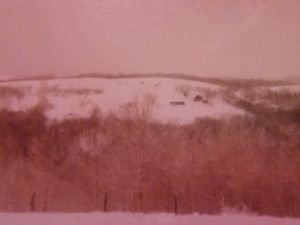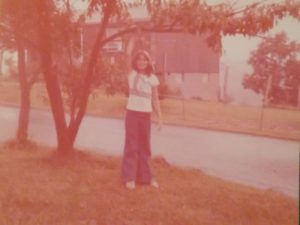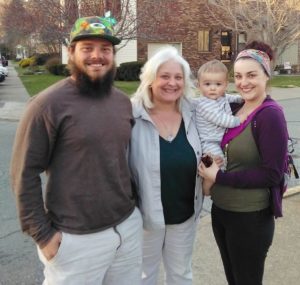Kelly Carter: Alice in Krishnaland
By Madhava Smullen for ISKCON New Vrindaban Communications
Kelly Carter, a science and social studies teacher at a middle school in Moundsville, never “joined” ISKCON. But she’s been a part of New Vrindaban longer than many devotees. Set to be honored at this spring’s Service Appreciation Ceremony, she has both love and a unique objectivity for the community that can teach us a lot and help guide us into the next fifty years of New Vrindaban.
Kelly moved to McCreary’s Ridge with her family when she was one year old in 1968, the year New Vrindaban was founded under Srila Prabhupada’s vision.
Interestingly, “New Vrindaban” is not one piece of land but many different plots on and around the Ridge, interspersed with land owned by local West Virginians. So whether they wanted it or not, devotees and locals were, and still are, part of the same broad community.

Kelly’s photo, taken from her front yard with a clear view of the Vrindaban farmhouse – circa, late 1970s.
“For me, the Hare Krishnas were just always there,” says Kelly. “My house was on a hill straight across from the original Vrindaban farm, so I could see their place from my yard.”
As devotees bought more property in the neighborhood, and people began to talk about the strange new people who had moved in, Kelly would see them walking down the road in their robes and shaved heads.
“The earliest interaction with a devotee that I can remember was probably when I was six or seven, and a lady came to ask if she could pick the flowers in our field,” Kelly says. “The devotees would gather flowers such as Queen Anne’s Lace to eat. They’d fry them in ghee, they said.”
As a small child, Kelly remembers being fascinated with the devotees and the large work horses they had. But she was upset with them too – with their rigidity and how they didn’t always act in a way she considered ‘normal’ and friendly.
“I would wave at them and be friendly with them, but they wouldn’t say ‘Hi’ back to me,” she recalls. “They would only say ‘Haribol,’ and I didn’t know what that meant. It really annoyed me. So finally I stopped one devotee walking with his big horses and said, “I told you hi. Why can’t you just say hi?’ Then he did. But he quickly added something like ‘Haribol’ again.”
In 1974, when Kelly was about seven years old, Srila Prabhupada visited New Vrindaban. Kelly’s interaction with him, while brief, made a big impression on her – his mood seemed different than that of some of his young disciples.
“I saw the devotees carrying him by, with lots of chanting and dancing,” she says. “I watched everyone go by, and then I waved to Prabhupada. He waved back, and smiled. I could tell that he was just thinking, ‘Aw, look at that sweet little girl waving to me, I’m going to wave back.’ And I remember thinking that he was much more friendly than some of the Hare Krishna people that lived there.”
Soon after, however, Kelly did meet many friendly devotees, and developed good relationships with them. At 8 or 9, the first devotee she ever really talked to, Vrindapati Das, took her to meet his wife and new baby boy.
With her parents divorced, her brothers at an age where they were “too old to play with her,” and few friends her age, Kelly began to take walks down to the nearby Prabhupada’s Palace, then under construction. In a different era, when children would spend all day outside, nobody really noticed.
“I felt like I was Alice in Wonderland,” she says. “I would walk down the road and into my own little world – the Hare Krishna community – that nobody knew about. I’d meet people from all over the world, and watch them build a Palace of Gold.”
As a young teenager, Kelly became a familiar face in New Vrindaban. She befriended and helped Narendra Das in the Palace’s stained glass workshop. She helped Jala-kolahali Das lay gold leaf on the Palace walls. And when she stopped by the ladies making garlands, they were happy to teach her.
“I was really appreciative of the devotees who were willing to take the time to teach me things and let me participate,” she says. “One of my fondest memories was, I got to know the devotee who worked in the Deity kitchen. He would make all these special things for the Deities, and after they were offered he’d let me try them. I was not a very adventurous eater as a child – I was a macaroni and cheese kind of girl – so this was all way out of my league! I remember my favorite was puris and tomato chutney.”
Later, Kelly also had various jobs in New Vrindaban, washing dishes and helping in the Palace gardens.
“Pretty much all the devotees were from a major city, and they would teach me about where they were from,” she says. “I learned about the world, and about a different culture. Back then, there wasn’t so much diversity here, and not many people traveled. So I gained a lot of skills that I wouldn’t have otherwise had the opportunity to gain. Now I travel a lot, and meet people from all walks of life. New Vrindaban taught me how to do that.”
Not everyone at the time liked or understood the devotees, who bought a lot of property in the area, including the local bar, which had been the social center of the neighborhood. Many saw them as extra weird hippies, nicknamed them “hairy critters,” and were prejudiced against them because of how different they were.
According to Kelly, devotees, however, were prejudiced against the local people too, pegging them as backward and devoid of culture. As Kelly grew up she received negative treatment as well: devotees variously tried to pressure her into joining, feared her “bad influence,” judged her harshly, and called her names like “Karmi Kelly.”
“I was raised a Catholic, and I thought that the locals weren’t treating the devotees in a Christian way,” says Kelly. “On the flipside, I would listen to the devotees teach about Krishna, and then see that they weren’t treating the local people in a Krishna conscious way.”
In the mid 1980s, Kelly moved to town, and didn’t keep in touch with devotees in New Vrindaban as much. More recently, she has begun to visit and be more involved. And she has seen positive changes in both the devotees and the locals.
The locals, she feels, are more open-minded, due to traveling more as well as the increasing popularity of Hare Krishna principles such as vegetarianism.
The devotees, she’s noticed, are more humble and wise. They’re also assimilating more into the broader community – devotees are out and about in town; coaching ball teams; and joining local gardening groups.
They’ve also invited Kelly to join the recently established New Vrindaban Village Association, and she has been happy to attend meetings.
“It sounds like they are much more open to embracing all aspects of the community, including the local people,” she says. “And I really appreciate that. I always wanted to see more unification, more appreciation for each other. Things could have been different if there had been more of that in the old days. Because the people who live here were good farmers – the devotees could have learned a lot from them. People could have helped each other more.”
But it isn’t too late, Kelly says. “I would like to see everybody – the broader local community, and the New Vrindaban community – becoming more and more accepting of and helpful to each other. And that has a better chance of happening now than it ever has. I think the time is ripe for some healing!”
It’s clear that Kelly wants to see New Vrindaban do well, and that it means a lot to her.
“I feel very lucky to have lived in a spiritual place like New Vrindaban,” she says. “I grew up there, built so many relationships, and I really feel like I’m part of the community – a community that helped shape my life.”





